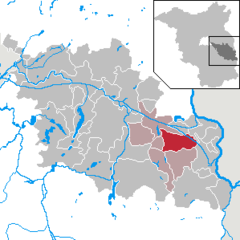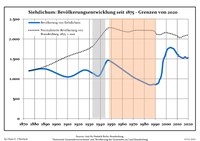Siehdichum


Siehdichum is a municipality in the Oder-Spree district, in Brandenburg, Germany. The name literally means "have a look around you".
History
The municipality of Siehdichum was formed in 2003 by merging the municipalities of Pohlitz, Rießen and Schernsdorf.
From 1815 to 1947, the constituent localities of Siehdichum were part of the Prussian Province of Brandenburg.
After World War II, Pohlitz, Rießen and Schernsdorf were incorporated into the State of Brandenburg from 1947 to 1952 and the Bezirk Frankfurt of East Germany from 1952 to 1990. Since 1990, they are again part of Brandenburg, since 2003 united as the municipality of Siehdichum.
Demography
-
 Development of population since 1875 within the current Boundaries (Blue Line: Population; Dotted Line: Comparison to Population development in Brandenburg state; Grey Background: Time of Nazi Germany; Red Background: Time of communist East Germany)
Development of population since 1875 within the current Boundaries (Blue Line: Population; Dotted Line: Comparison to Population development in Brandenburg state; Grey Background: Time of Nazi Germany; Red Background: Time of communist East Germany)
|
|
|
References
- ^ Landkreis Oder-Spree Wahl der Bürgermeisterin / des Bürgermeisters, accessed 2 July 2021.
- ^ "Bevölkerungsentwicklung und Bevölkerungsstandim Land Brandenburg Dezember 2022" (PDF). Amt für Statistik Berlin-Brandenburg (in German). June 2023.
- ^ Detailed data sources are to be found in the Wikimedia Commons.Population Projection Brandenburg at Wikimedia Commons
- v
- t
- e
- Bad Saarow
- Beeskow
- Berkenbrück
- Briesen
- Brieskow-Finkenheerd
- Diensdorf-Radlow
- Eisenhüttenstadt
- Erkner
- Friedland
- Fürstenwalde
- Gosen-Neu Zittau
- Groß Lindow
- Grünheide
- Grunow-Dammendorf
- Jacobsdorf
- Langewahl
- Lawitz
- Mixdorf
- Müllrose
- Neißemünde
- Neuzelle
- Ragow-Merz
- Rauen
- Reichenwalde
- Rietz-Neuendorf
- Schlaubetal
- Schöneiche
- Siehdichum
- Spreenhagen
- Steinhöfel
- Storkow
- Tauche
- Vogelsang
- Wendisch Rietz
- Wiesenau
- Woltersdorf
- Ziltendorf

 | This Brandenburg location article is a stub. You can help Wikipedia by expanding it. |
- v
- t
- e










